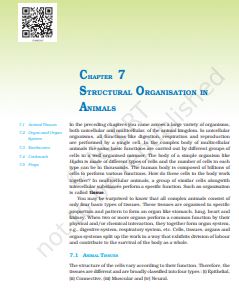‘NCERT Solutions for Class 11 Biology Chapter 7 Structural Organization In Animals’ PDF Quick download link is given at the bottom of this article. You can see the PDF demo, size of the PDF, page numbers, and direct download Free PDF of ‘Ncert Class 11 Biology Chapter 7 Exercise Solution’ using the download button.
Structural Organization in Animals NCERT Textbook With Solutions PDF Free Download

Chapter 7: Structural Organization in Animals
In the preceding chapters, you came across a large variety of organisms, both unicellular and multicellular, of the animal kingdom.
In unicellular organisms, all functions like digestion, respiration, and reproduction are performed by a single cell.
In the complex body of multicellular animals, the same basic functions are carried out by different groups of cells in a well-organized manner.
The body of a simple organism like Hydra is made of different types of cells and the number of cells in each type can be in the thousands.
The human body is composed of billions of cells to perform various functions. How do these cells in the body work together?
In multicellular animals, a group of similar cells along with intercellular substances perform a specific function. Such an organization is called tissue.
You may be surprised to know that all complex animals consist of only four basic types of tissues. These tissues are organized in specific proportions and patterns to form an organ like the stomach, lung, heart, and kidney.
When two or more organs perform a common function by their physical and/or chemical interaction, they together form an organ system, e.g., digestive system, respiratory system, etc.
Cells, tissues, organs, and organ systems split up the work in a way that exhibits division of labor and contributes to the survival of the body as a whole.
7.1 Animal Tissues
The structure of the cells varies according to their function. Therefore, the tissues are different and are broadly classified into four types : (i) Epithelial, (ii) Connective, (iii) Muscular and (iv) Neural.
7.1.1 Epithelial Tissue
We commonly refer to an epithelial tissue as epithelium (pl.: epithelia). This tissue has a free surface, which faces either a body fluid or the outside environment and thus provides a covering or a lining for some part of the body.
The cells are compactly packed with little intercellular matrix.
There are two types of epithelial tissues namely simple epithelium and compound epithelium. Simple epithelium is composed of a single layer of cells and functions as a lining for body cavities, ducts, and tubes.
The compound epithelium consists of two or more cell layers and has a protective function as it does in our skin. On the basis of structural modification of the cells, the simple epithelium is further divided into three types. These are (i) Squamous, (ii) Cuboidal, (iii) Columnar.
| Author | NCERT |
| Language | English |
| No. of Pages | 23 |
| PDF Size | 4.3 MB |
| Category | Biology |
| Source/Credits | ncert.nic.in |
NCERT Solutions Class 11 Biology Chapter 7 Structural Organization in Animals
1. Answer in one word or one line.
(i) Give the common name of Periplanata Americana.
(ii) How many spermathecae are found in earthworms?
(iii) What is the position of ovaries in cockroach?
(iv) How many segments are present in the abdomen of cockroach?
(v) Where do you find Malpighian tubules?
Solution:
i) American cockroach
ii) 4 pairs of spermathecae are found in earthworm
iii) Two ovaries are found lying laterally around 2nd to 6th abdominal segments.
iv) 10 segments
v) Malpighian tubules are found at the junction of midgut and the hindgut of the alimentary canals of insects.
2. Answer the following:
(i) What is the function of nephridia?
(ii) How many types of nephridia are found in earthworm based on their location?
Solution:
i) Nephridia perform the function of excretion and osmoregulation in earthworms.
ii) Three types of nephridia are found in the earthworm based on their location they are:
- Septal nephridia present on both the sides of intersegmental septa of segment 15 to the last that opens into the intestine.
- Integumentary nephridia are attached to the lining of the body wall of segment 3 to the last that opens on the body surface.
- Pharyngeal nephridia is present as three paired tufts in the 4th, 5th and 6th segments.
3. What is periderm? How does periderm formation take place in the dicot stems?
Solution:
Phellogen, phellem, and phelloderm are collectively known as periderm. While plants undergo secondary growth, the outer epidermal layer and the cortical layer are ripped due to cambium.
In order to replace them, the cortex cells turn meristematic which produces the cork cambium or the phellogen which comprises thin-walled, narrow, and rectangular cells.
The phellogen sheds cells on either side. The cells which shed from the exterior give rise to the cork or phellem.
The suberin accumulates in its cell wall making it impermeable to water while the inner cells emerge to become the secondary cortex or phelloderm which is parenchymatous.
4. Mention briefly the circulatory system of earthworm
Solution:
- The earthworm has a closed circular system that comprises of blood vessels, capillaries, and the heart.
- In earthworms, blood is confined to the heart and blood vessels as it is a closed circulatory system
- Contraction keeps blood circulating in one direction.
- Blood glands are present on the 4th, 5th, and 6th segments. They produce blood cells, hemoglobin, that are dissolved in the plasma of the blood.
- Blood cells and are phagocytic.
- Specilazied breathing system is absent hence the moist body surface helps in the respiratory exchange with their bloodstream
NCERT Class 11 Biology Textbook Chapter 7 Structural Organization in Animals With Answer PDF Free Download
